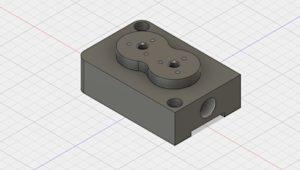What is material “hardness” in CNC manufacturing?
In the context of materials science, "hardness" typically refers to the material's ability to withstand indentation, scratching, or other forms of surface penetration when subjected to mechanical forces or abrasive conditions. Hard materials are less likely to undergo wear, deformation, or damage, making them suitable for applications where durability is essential.
Hardness and strength – what is the difference?
Hardness and strength are different properties. Hardness is the resistance of a material to indentation or abrasion on the external surfaces, while strength is the ability to withstand an applied load without failure or permanent deformation. Materials can also be treated in various ways to improve their strength and/or surface hardness. These are the most common categories of material strength.
-
Compressive strength. This property indicates the maximum load a material can endure in compression before collapsing. Manufacturers often consider compressive strength when designing components that must support heavy loads in industrial machinery and equipment.
-
Tensile strength. Tensile strength represents the maximum stress a material can withstand while being pulled before it breaks. It is crucial in manufacturing applications subjected to high degrees of tension, such as hanging tools, wires, cables, and structural elements for buildings and bridges.
-
Yield strength. Yield strength helps manufacturers understand a material's limit before it undergoes permanent deformation. It is significant for metal components that must maintain their shape and structural integrity, such as those intended for load-bearing applications.
-
Impact strength. This property indicates how well a material can resist fractures or breakage when subjected to sudden forces, dynamic loads, or impact. Manufacturers rely on materials with high impact strength for producing durable parts used in machinery, tools, and automotive components.
What are the hardest materials for CNC manufacturing?
Here are a few materials that industrial customers often use to create parts or components meant for hardworking environments.
-
Stainless steel. Possesses high tensile strength, corrosion resistance, and durability. It maintains its structural integrity in diverse environments, making it valuable for construction and manufacturing. However, it can be less hard than some materials and is susceptible to scratching or denting, impacting its surface finish, unless it is heat treated.
-
Tool steel. Exhibits high hardness, wear resistance, and toughness. It's often used for precision cutting tools and dies, ensuring prolonged tool life and dimensional accuracy. However, steel can be brittle and prone to chipping under extreme stress, necessitating careful handling and maintenance.
-
Alloy steel. Showcases high tensile strength, wear resistance, and toughness. Alloy steel is crucial used in applications ranging from heavy machinery to structural components, offering enhanced strength and durability. Alloy steel can be challenging to machine due to its hardness, requiring specialized tooling and processes.
-
Titanium. Offers high tensile strength, a density that is lower than steel (but higher than aluminum), and corrosion resistance. It also has very low heat conductivity, with a strength-to-weight ratio that makes it ideal for aerospace, automotive, and medical industry applications. Titanium can be challenging to machine due to its hardness, demanding specialized equipment.
-
Inconel. A high-strength and corrosion-resistant nickel alloy that is used for aerospace, chemical, and automotive applications. It can be challenging to machine due to its hardness and tendency to work-harden – meaning it can become harder and more brittle as it is deformed. This can necessitate specialized tools and techniques and negatively affects the tools’ lives.
-
Tungsten. Has a high melting point, tensile strength, a decent hardness, and low thermal expansion. Tungsten is used in high-temperature applications. It is brittle at room temperature and can be challenging to machine.
-
Chromium. Offers high hardness, corrosion resistance, and wear resistance. Because pure chromium is brittle, it is best used as an alloy and in the production of stainless steel
Best practices for improving material hardness
By following these best practices, you can take steps toward enhancing material hardness. Properly hardened materials can withstand higher stresses, resist wear, and maintain structural integrity, reducing the risk of failure and costly replacements. Additionally, compliance with these practices can be a legal requirement in regulated industries.
-
Heat treatment. Proper heat treatment processes, such as quenching and tempering, can significantly enhance material hardness by altering its microstructure.
-
Alloying. Incorporating alloying elements, such as chromium, molybdenum, or vanadium, into the material composition can increase hardness.
-
Cold working. Cold working is a manufacturing process where a material is deformed or shaped at room temperature or below, increasing its strength and altering its mechanical properties without heating.
-
Thermochemical treatments. Techniques like carburizing or nitriding can harden the surface of materials, improving wear resistance.
Precise machining. Using appropriate cutting tools and techniques, as well as slower cutting speeds during machining can help maintain hardness, avoid overheating and softening the material.
Find out more about selecting materials for CNC machining, 3D printing and injection molding. You can also read more about material properties on our Knowledge Base. For pricing and lead times for your custom parts, upload a CAD file to our quote builder.
Frequently asked questions
What are hard materials in CNC machining?
Hard materials are those that can withstand indentation, scratching, or other forms of surface penetration when subjected to mechanical forces or abrasive conditions.
How does cutting speed affect machining hard materials?
Slower cutting speeds are usually required for hard materials to prevent excessive tool wear.
What are common applications for CNC machining hard materials?
Aerospace and automotive components, heavy machinery, medical implants, and high-performance tools often use hard materials.
What are the benefits of machining hard materials?
Machining hard materials can result in components with excellent wear resistance, durability, and precision.

















